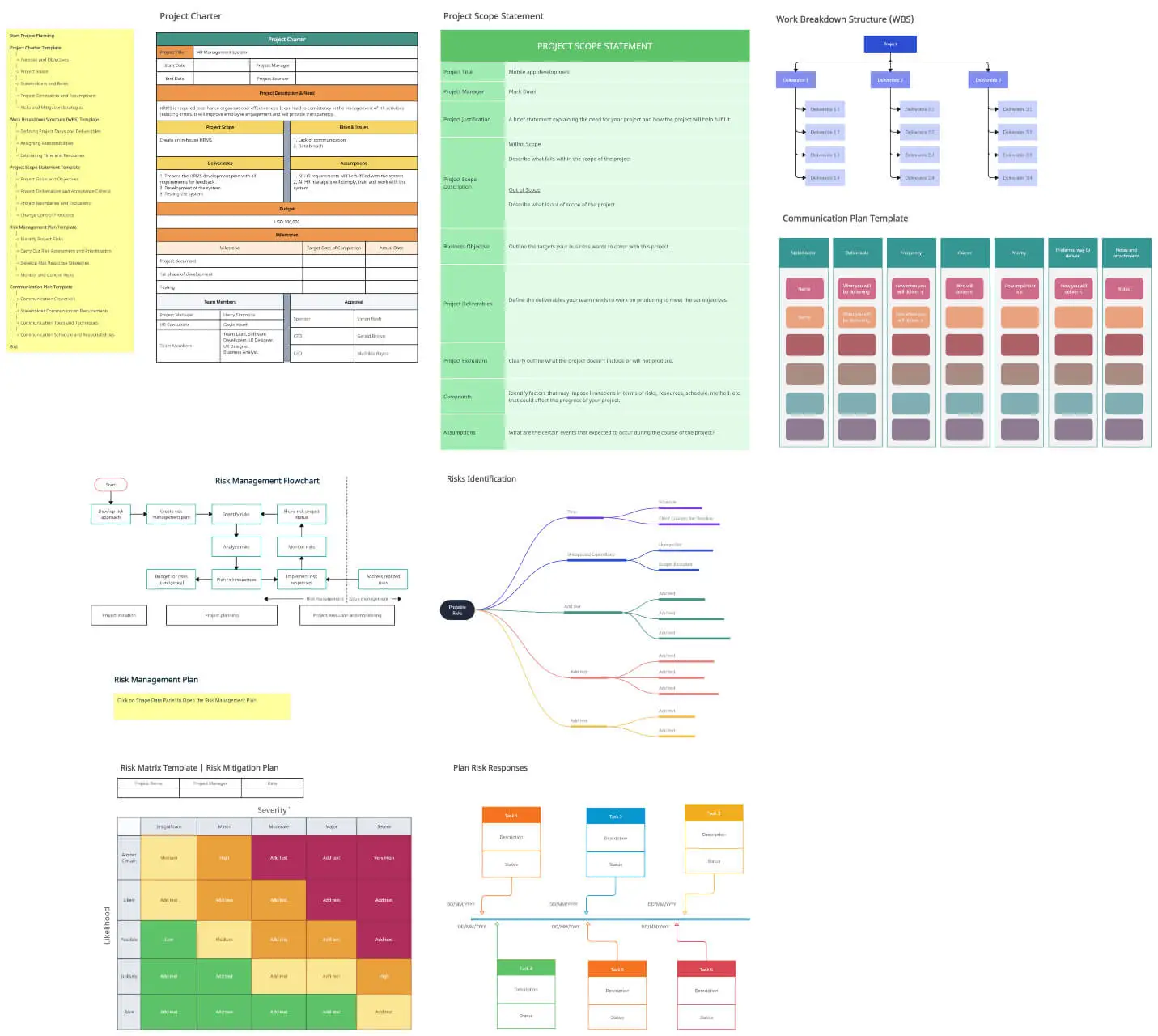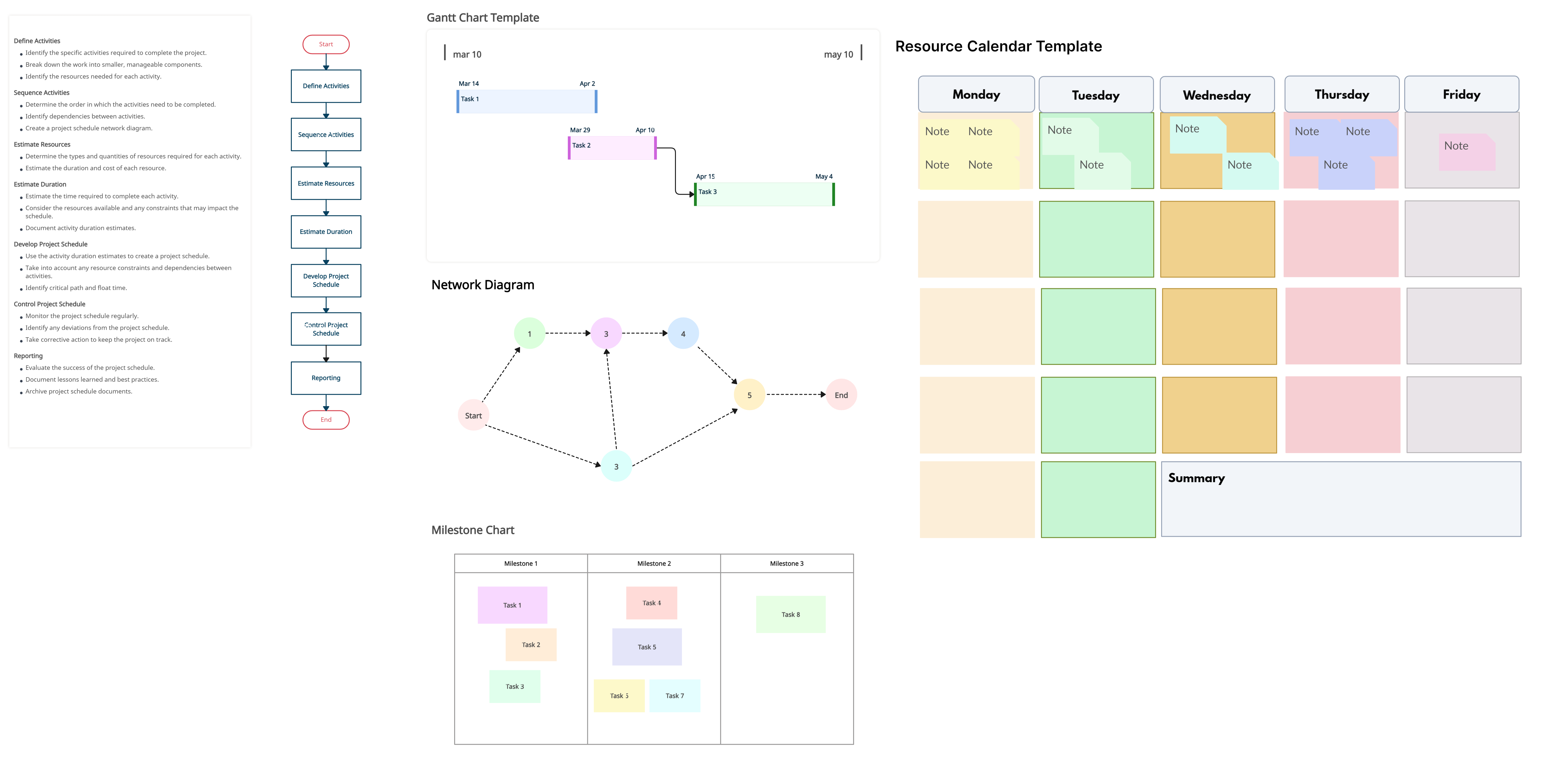Project planning and scheduling are essential components of successful project management. They provide a roadmap for project execution, ensuring that tasks are completed on time, within budget, and in line with project objectives. However, creating project plans and schedules from scratch can be time-consuming and prone to errors. That’s where you can use editable project plan templates and project schedule management plan templates to quickly and easily create project plans and schedules that are error-free.
In this article, we will explore the benefits of using project planning and scheduling templates. Scroll down to also see a collection of editable templates that project managers can use to streamline their project management processes. These templates will serve as valuable resources, enabling project managers to efficiently plan and schedule their projects while maintaining consistency and adhering to best practices.
Project Plan Templates
Planning is considered the most crucial phase of project management. It sets the foundation upon which the entire project is built and managed. To streamline this process and ensure its effectiveness, let’s take a look at several editable templates that could be used in project planning.

Project Charter Template
The project charter is a critical document that officially recognizes the existence of a project and provides a summary of its key aspects. It serves as a contract between the project sponsor, key stakeholders, and the project team.
Our Project Charter Template includes the following essential components,
Purpose and Objectives: Clearly articulate why the project is undertaken and what it aims to achieve. This section should align with your organization’s strategic goals.
Project Scope: Define the boundaries of your project—what will be included and what will not. This will help avoid scope creep during the project execution phase.
Stakeholders and Roles: Identify key stakeholders, including the project sponsor, project team, and other parties involved. Clarify their roles and responsibilities to avoid confusion and conflict later.
Project Constraints and Assumptions: List out any limitations such as budget, resources, and time, as well as any assumptions made during the planning process.
Risks and Mitigation Strategies: Identify potential risks that could impact your project and outline strategies to mitigate them.
Work Breakdown Structure (WBS) Template
The WBS is a visual, hierarchical representation of the work to be done on a project. It breaks down the project into manageable chunks, making it easier for the team to understand and complete the work.
Our WBS Template will guide you through:
Defining Project Tasks and Deliverables: Identify all the tasks required to complete the project and the deliverables that each task will produce.
Assigning Responsibilities: Assign each task to a team member or a group. This clarifies who is responsible for what and ensures that all tasks are covered.
Estimating Time and Resources: Estimate how long each task will take and the resources needed. This is critical for creating an accurate project schedule and budget.
Project Scope Statement Template
While the project charter broadly outlines the project scope, the scope statement goes into greater detail. It is a key document that helps manage stakeholder expectations and control scope creep.
Our Project Scope Statement Template includes,
Project Goals and Objectives: Detail what the project will accomplish. The goals and objectives should be SMART (Specific, Measurable, Achievable, Relevant, and Time-bound).
Project Deliverables and Acceptance Criteria: List what the project will produce and the criteria for accepting each deliverable. This helps ensure that the project team and stakeholders have the same understanding of what will be delivered.
Project Boundaries and Exclusions: Clearly state what is outside the project’s scope. This prevents misunderstandings and scope creep.
Change Control Processes: Outline how changes to the project scope will be handled. This helps keep the project on track even when changes are necessary.
Risk Management Plan Template
Risk is an inevitable part of any project. It’s essential to plan ahead for potential challenges that might occur during the project life cycle. A Risk Management Plan is a document that helps you identify, evaluate, and prioritize risks, and develop strategies to manage them effectively.
Our Risk Management Plan Template will help you to,
Identify Project Risks: List out the potential risks that could impact your project. These risks could be related to resources, stakeholders, technology, or any other aspect of the project.
Carry Out Risk Assessment and Prioritization: Assess each risk based on its likelihood of occurrence and its potential impact on the project. Prioritize the risks based on this assessment.
Develop Risk Response Strategies: Develop strategies for managing each risk. This could involve avoiding, mitigating, transferring, or accepting the risk.
Monitor and Control Risks: Define how you will monitor the identified risks and how you will control them if they occur. This ensures you are well-prepared to handle risks effectively.
Communication Plan Template
Effective communication is the backbone of successful project management. A Communication Plan outlines who needs to be a part of the communication, what information they need, when and how often they need it, and who will provide it.
Our Communication Plan Template includes,
Communication Objectives: Define the purpose of each communication. This ensures that communication is always purposeful and effective.
Stakeholder Communication Requirements: Identify who needs what information. This ensures that everyone gets the information they need to fulfill their roles effectively.
Communication Tools and Techniques: Decide on the tools and techniques you will use for communication. These could be meetings, emails, reports, or project management software.
Communication Schedule and Responsibilities: Determine when each communication will take place and who will be responsible for it. This ensures that communication happens regularly and effectively.
Project Schedule Management Plan Templates
After the planning phase, scheduling is the next critical step. It involves listing all project tasks, their start and end dates, durations, and dependencies. Effective scheduling helps ensure that the project stays on track and finishes on time. Our project schedule management plan templates will assist you in creating an effective schedule.

Project Schedule Template
Creating a comprehensive project schedule is critical to ensure that all tasks are accounted for and completed within the stipulated time frame. A well-constructed project schedule serves as a roadmap for the project’s course.
Our Project Schedule Template will guide you through,
Task Dependencies and Sequencing: Identify the sequence of tasks based on their interdependencies. This will help in constructing a logical flow of activities.
Time Estimation Techniques: Use various techniques such as the Program Evaluation and Review Technique (PERT) or the Critical Path Method (CPM) to estimate the time needed for each task.
Scheduling Baselines and Milestones: Establish a schedule baseline to measure the project’s progress. Also, identify key milestones to signify important phases or achievements within the project timeline.
Resource Allocation and Leveling: Allocate resources to each task effectively to ensure that no resources are over, or underutilized.
Gantt Chart Template
A Gantt Chart is a visual representation of the project schedule, providing a clear overview of the project timeline, tasks, and their respective deadlines.
Our Gantt Chart Template includes:
Visual Representation of Project Schedule: Visualize all project tasks, their start and end dates, and durations in a clear, graphical format.
Key Project Milestones: Highlight critical milestones that signify important points within the project timeline.
Tracking Progress and Identifying Schedule Variances: Update the Gantt Chart as the project progresses to reflect completed tasks and identify any variances from the original schedule.
Critical Path Method (CPM) Template
The Critical Path Method is a technique used to identify the longest sequence of tasks in a project schedule. It helps to determine the shortest possible project duration and provides a clear picture of task dependencies.
Our CPM Template will assist you in,
Identifying the Critical Path: Determine the sequence of tasks that forms the critical path. These are the tasks that will directly impact the project’s duration.
Analyzing Project Schedule Flexibility: Identify which tasks have float or slack, i.e., can be delayed without affecting the project’s end date.
Using the Critical Path for Schedule Compression and Optimization: If the project duration needs to be shortened, the tasks on the critical path are the ones to focus on.
Schedule Risk Analysis Template
Schedule risk analysis helps to identify potential risks that could impact the project schedule and formulate strategies to mitigate them.
Our Schedule Risk Analysis Template guides you in,
Identifying Schedule Uncertainties: Identify elements in the schedule that have a degree of uncertainty, which can lead to potential risks.
Quantitative Risk Analysis Techniques: Apply techniques such as Monte Carlo simulation to quantify the impact of identified risks.
Scheduling Contingency Planning: Develop contingency plans to address the risks if they occur, thereby reducing their potential impact on the schedule.
Customizing and Integrating Templates
While templates provide a solid structure and starting point for your project management activities, it’s essential to remember that every project is unique. Therefore, these templates should be adapted to fit the specific needs of your project.
Adapting Templates to Specific Project Needs
Each project has unique characteristics–different team dynamics, varying stakeholder requirements, diverse risks, and more. As such, while our templates offer comprehensive guidelines, you should modify and tailor them to suit your particular project requirements. Always remember that these templates are only tools meant to be customized to your needs.
Integrating Templates with Project Management Software
Many project managers use project management software for increased efficiency and better project control. The good news is that our templates can be easily integrated into most project management software. This integration allows you to enjoy the benefits of the software while retaining the structured format of the templates.
Ensuring Template Compatibility with Organizational Processes and Standards
Each organization may have its own unique processes and standards when it comes to project management. When using these templates, it’s important to ensure that they align with your organization’s standards and processes. This might require some adjustments and fine-tuning.
Frequently Asked Questions (FAQs)
1. What are the parts of a project plan?
The main five parts of a project plan typically include:
Project Charter: The project charter outlines the overall purpose, objectives, and stakeholders of the project. It establishes the authority and responsibilities of the project manager and provides a high-level overview of the project’s scope, timeline, and budget.
Work Breakdown Structure (WBS): The WBS is a hierarchical decomposition of the project’s deliverables and activities. It breaks down the project into smaller, manageable components called work packages, which can be assigned to specific team members or groups. The WBS helps in organizing and understanding the project’s scope, tasks, and dependencies.
Project Scope Statement: The project scope statement defines the boundaries, objectives, and deliverables of the project. It clearly outlines what is included and excluded from the project, as well as the criteria for its success. The scope statement serves as a reference point to ensure that the project stays on track and that any changes or additions are properly evaluated and approved.
Risk Management Plan: The risk management plan identifies potential risks and outlines strategies to mitigate or respond to them. It includes a risk assessment, which involves identifying and analyzing risks, as well as risk response strategies, such as avoidance, mitigation, transfer, or acceptance. The plan helps in proactively managing and minimizing the impact of uncertainties on the project’s success.
Communication Plan: The communication plan outlines how project information will be shared, who will be responsible for communication, and what channels and tools will be used. It includes a stakeholder analysis to identify the key individuals or groups involved in or affected by the project. The plan establishes guidelines for effective communication, ensuring that the right information is delivered to the right stakeholders at the right time, and fostering collaboration and transparency throughout the project.
2. How can I write a project plan?
Here are the general steps to write a project plan:
Define the project scope, objectives, and deliverables.
Identify the tasks and activities required to achieve the project objectives.
Determine the order and dependencies of the tasks, creating a work breakdown structure (WBS).
Estimate the time, effort, and resources required for each task.
Develop a project timeline or schedule, including milestones and deadlines.
Identify potential risks and develop a risk management plan.
Create a communication plan to keep stakeholders informed.
Assign responsibilities and roles to team members.
Define the project’s budget and allocate resources accordingly.
Monitor and track progress throughout the project, making adjustments as needed.
3. What is a project plan template?
A project plan template is a pre-designed document that provides a structure and framework for creating a project plan. It typically includes sections and placeholders for key information such as project objectives, scope, tasks, milestones, timelines, resources, and more. Project plan templates can be found in various formats, such as Word documents, Excel spreadsheets, or project management software like Creately.
4. What is project planning in PMO?
Project planning in PMO (Project Management Office) refers to the process of creating and managing project plans within an organization’s PMO. The PMO is responsible for providing centralized support and oversight to projects, ensuring consistency, adherence to standards, and effective resource allocation. Project planning in PMO involves standardizing project management practices, creating templates and guidelines, monitoring project progress, providing guidance to project managers, and facilitating communication and collaboration across projects.
5. What is a project schedule template?
A project schedule template is a pre-designed document or tool that helps project managers and teams organize and plan the various tasks and activities involved in a project. It typically includes timelines, milestones, dependencies, and resource allocations to ensure smooth project execution.
6. How do you write a project schedule?
To write a project schedule, follow these steps:
Identify project tasks: Break down the project into individual tasks that need to be completed.
Determine task dependencies: Find which tasks are dependent on others and establish their sequence.
Estimate task durations: Estimate the amount of time required to complete each task.
Allocate resources: Assign the necessary personnel and equipment to each task.
Consider constraints: Take into account any constraints or limitations that may impact the schedule, such as resource availability or external dependencies.
Define milestones: Identify key checkpoints or milestones to track progress.
Develop the schedule: Use a scheduling tool or software to create a timeline that incorporates all the tasks, dependencies, durations, resources, and milestones.
Review and adjust: Review the schedule for feasibility and make adjustments as necessary to ensure a realistic and achievable timeline.
Wrapping Up
Project planning and scheduling are two critical aspects of project management that can significantly influence a project’s success. By using these project plan and schedule management templates, project managers can ensure that their plans are comprehensive, accurate, and tailored to their specific needs.
These templates serve as a roadmap, guiding you through each stage of the project, from initial planning to scheduling and risk assessment. They can help streamline your processes, reduce errors, and ensure consistency across all your projects.
We encourage you to customize and use these templates to effectively manage your projects and achieve your project goals. Do share this article and these valuable templates with your fellow project managers, helping them also to deliver successful projects.



![What is a Project Initiation Document (PID)? [with Free Template]](/static/assets/guides/project-initiation-document-explained/hero.webp)

